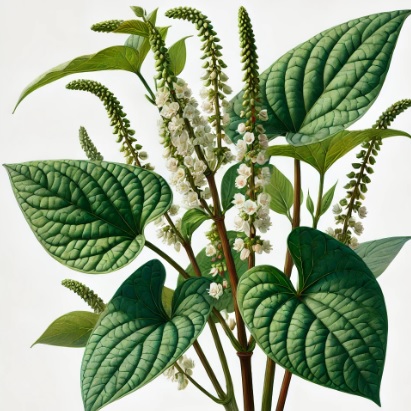Japanese knotweed (Polygonum cuspidatum), commonly known as Fallopia japonica, is a perennial plant native to East Asia, including Japan, China, and Korea. It is recognized for its rapid growth, robust stems, and broad, heart-shaped leaves. The plant is notable for its invasive tendencies in some regions, where it can outcompete native flora.
Botanical Classification:
Kingdom: Plantae
Order: Caryophyllales
Family: Polygonaceae
Genus: Polygonum
Species: Polygonum cuspidatum
Plant Characteristics:
Polygonum cuspidatum is characterized by:
Flowers: Small, creamy-white to greenish-white flowers arranged in dense clusters. These bloom from late summer to early fall.
Foliage: Large, broad, heart-shaped leaves with a pointed tip. The leaves are green with a smooth texture and can be quite large, adding to the plant's dense appearance.
Growth Habit: A robust, perennial herbaceous plant that can reach heights of 2 to 3 meters. It spreads aggressively through rhizomes, leading to dense colonies.
Soil and Light: Thrives in a variety of soil types, including moist and well-drained soils. It prefers full sunlight but can tolerate partial shade. It is highly adaptable and can grow in a range of environmental conditions.
Chemical Composition and Structure:
The chemical composition of Polygonum cuspidatum includes:
Resveratrol: A polyphenolic compound found in the plant's roots and stems, known for its antioxidant properties.
Emodin: An anthraquinone derivative present in the plant, contributing to its potential laxative and anti-inflammatory effects.
Tannins and Flavonoids: Found in the leaves and stems, providing additional antioxidant and anti-inflammatory properties.
Polysaccharides: Present in the plant, which may contribute to its potential immune-boosting effects.
Uses and Benefits:
Medicinal: Polygonum cuspidatum is used in traditional medicine for its potential anti-inflammatory, antioxidant, and antimicrobial properties. It is particularly valued for its high resveratrol content, which is believed to support cardiovascular health and longevity.
Cosmetic: Extracts of Polygonum cuspidatum are incorporated into skincare products for their antioxidant properties, helping to protect the skin from environmental damage.
Herbal Remedies: Often used in traditional herbal medicine for its potential benefits in treating various conditions, including joint pain and digestive issues.
Applications:
Gardening: Due to its invasive nature, it is generally not recommended for ornamental gardens. It is better suited to controlled environments where its spread can be managed.
Cosmetics: Extracts are used in skincare formulations for their antioxidant and anti-inflammatory benefits.
Medicinal: Utilized in traditional and alternative medicine practices for its potential health benefits, particularly for its resveratrol content.
Environmental and Safety Considerations:
Environmental Impact: Highly invasive in some regions, Polygonum cuspidatum can outcompete native species and alter local ecosystems. Management and control measures are often necessary to prevent its spread.
Safety: Individuals allergic to plants or with very sensitive skin should be cautious. Consulting with a healthcare provider before using Polygonum cuspidatum for medicinal purposes is advisable, especially for individuals with underlying health conditions or those taking other medications.
INCI:
Skin conditioning agent. It is the mainstay of topical skin treatment as it has the function of restoring, increasing or improving skin tolerance to external factors, including melanocyte tolerance. The most important function of the conditioning agent is to prevent skin dehydration, but the subject is rather complex and involves emollients and humectants that can be added in the formulation.
Synonyms:
CAS:
![]() Japanese knotweed
Japanese knotweed 

